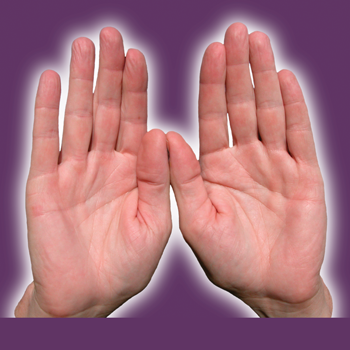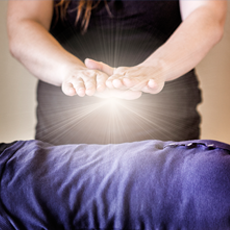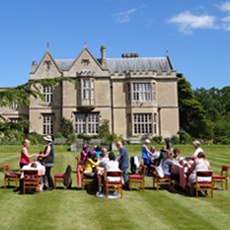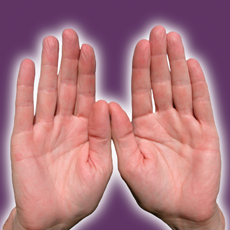by Frank Arjava Petter
Byosen, translated as “sick accumulation,” is the frequency that is emitted from a tense, injured or ill body part. It is also the reaction of the body to incoming Reiki energy. By evaluating these two aspects of thebyosen, the practitioner can discover the area or areas that most need treatment, know how long the hands should remain in a particular area, and know whether additional treatments are indicated.
As noted in Part I of this article, byosen has five distinct levels, which indicate the seriousness of the condition, with five being the highest degree of imbalance:
Levels of byosen
- Heat. This heat is above normal body temperature.
- Strong heat. This heat makes your palms sweat.
- Tingling. The tingling can be experienced as pins and needles, as a magnetic feeling, or as your hands falling asleep.
- Pulsation, cold. The pulsation can be strong or weak, slow or fast. When the place you touch feels cold, it is not the fault of your hands, but a sign of byosen level four.
- Pain in the hand of the practitioner. This pain may be felt in the hand, in the fingers or in the back of the hand. It may move up your hand into the forearm, and may continue all the way up to your shoulder.
Working with the byosen
Both Usui sensei and Hayashi sensei gave their beginner students handbooks that explained hand positions to be used for the most common ailments of that time. The handbooks allowed students to work effectively with Reiki before they understood the more advanced art ofbyosen. Once students became proficient in byosen, they listened to the body of the client and to the workings of the energy rather than relying on a specific pattern of hand positions.
Byosen is not to be confused with psychic ability or intuition. The Japanese approach is not exclusively intuitive. It is based on perception. Being perceptive can be learned, and this happens most easily in the presence of a skilled teacher. I have observed over the years that the teacher’s expertise flows naturally to his or her students as a result of their being in the teacher’s physical presence. This is the natural law of the spirit. The higher vibration transforms the lower.
In order to be perceptive, one needs to increase awareness. Begin by being aware of all the information that your senses provide for you. Look at the body of your client with the utmost attention and awareness. Notice every little thing. The client may not know what he needs, but his body does. His body will give you signs in the form of the five levels ofbyosen. The byosen attracts your attention; it pulls your hands to itself. Also the byosen tells you how the healing is going as well as how to proceed.
The first technique is really not a technique at all but simply a response to information from the client. A client comes to you and tells you what his physical problem is. He has been diagnosed by a healthcare practitioner. Perhaps he experiences pain or discomfort in a particular area of his body. You place your hands on that area and feel the byosen. If you feel a strong byosen, level four or five, you know that something serious is happening there that needs serious and possibly time-consuming attention. As you hold your hands on this area you pay attention to the peaks and valleys of the byosen. It comes and goes in waves. You continue working with the client until the peaks have diminished to level two or one.
The effectiveness of this technique was demonstrated in a dramatic way during one of my seminars. A participant was supposed to have her gallbladder removed a few days after the workshop. She had developed very painful stones and the doctors saw no other way for her than surgery. Every day, for five days I worked on her with the group. On the first day I felt a strong level five byosen. During the treatment one of us held her head, one held her feet, two or three held other positions, and I placed my hands on the gallbladder for the duration of the treatment. The byosen changed after two peaks and dropped to a strong level four. I felt coldness in the area, an indication of level four. I imagined the stones turning to dust. The next day we began again with a light level five and from then on the byosen dropped dramatically. On the third day, all I felt was a strong tingle—level three. By the end of the training, after five days, only heat could be felt. I urged her to have a checkup before surgery because I knew that the body was taking good care of itself. Her healing powers were activated, and I was confident that the body could heal itself. All the others felt it as well. The surgery was cancelled by a surprised physician.
Byosen is a powerful tool for increasing the effectiveness of Reiki and enhancing the outcome of Reiki treatments. I encourage you to experiment with each of the techniques described and to discover for yourself how amazingly effective byosen can be. Working withbyosen requires practice and patience, but I believe you will find that the results make it well worth the effort.
*The word Gassho means two hands coming together. The correct way to practice Gasshois to hold the hands up, with the palms close together. Each finger is supposed to lie upon the respective finger of the other hand. The hands are held so that the finger-tips are just below the nose. The elbows are not touching the body, but there is enough space in between the inside of the upper arm and the armpit to fit in an egg. The back is held erect and the head floating up by itself as if held up by a helium-filled balloon.
This is an excerpt from the complete article that appeared in the Summer 2007 issue of Reiki News Magazine.







